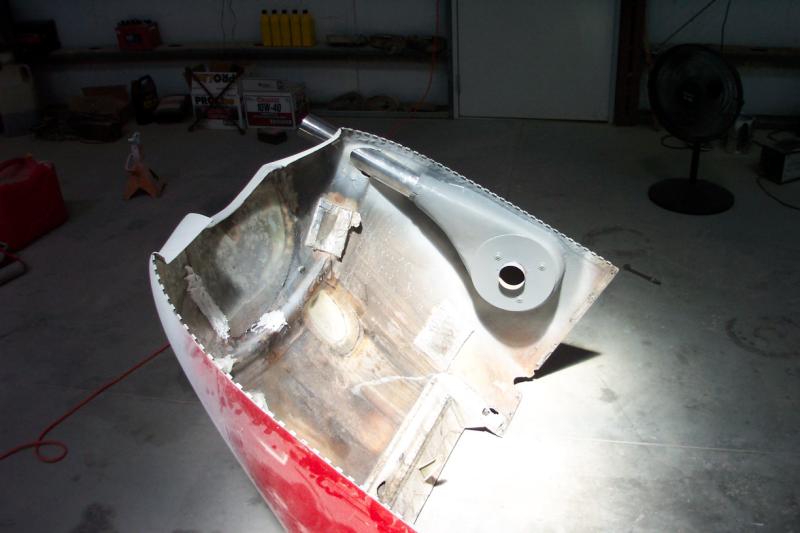The principles of divergent duct design are well known among the aviation community. Divergent ducts transform high velocity/low density air into low velocity/high pressure air by virtue of a smoothly expanding plenum volume. A slow moving, stable reservoir of high density air is very useful for many things in an aircraft, particularly piston engine induction. Like many things in aircraft design however, the "optimum" shape often does not fit within the confines of the aircraft structure. We see this most readily in typical air cooling of aircraft. The inlets are short, the air flow takes a tortuous path, and the exit is usually an afterthought. Induction systems are often no better- many with nothing more than a crude metal snorkel attached to the carb/servo and stuck out into the airstream through a hole in the front of the cowl.
But what if we had the real estate to really fit an idealized duct to an airplane? The picture below shows my initial attempt at putting the theory to practice. While far from "optimal", it nevertheless showed impressive gains.

So... The goal of this duct is to provide the servo (in my case) an ample supply of stable, high density air with the somewhat conflicting goal of minimizing airframe drag. It has to provide zero restriction at full throttle, full RPM and zero airspeed, as well as not spilling out the inlet and creating drag at 200+ knots.
So we need a relatively small inlet feeding a duct/plenum of large volume. To do this and not exceed the textbook maximum of 7 degrees divergence takes some space. When it comes to volume of the plenum, "too much" is far better than "too little". A big plenum provides stability and supports high air density. Think of a rushing, turbulent river feeding a deep, placid lake...
There is great discussion concerning many of these principles in Ross' thread on his radiator duct work (and I hope this thread catches his eye), but this application differs in the fact that the system is somewhat closed on the exit. Where a cooling system tries to accelerate the captured air back to aircraft speed after use, an induction plenum has only a "leakage rate" defined by the CFM requirements of the engine. In my case, my 540 Lycoming requires a theoretical 422 CFM at an unrealistic 100% VE. (CID*RPM*VE/3456). As stated earlier, the plenum will "exit" 422 CFM regardless of forward speed.
Still with me? Here's where this thread turns into a question: If the design of a divergent duct captures the energy of inrushing air and turns it into high density, slow air - at what point in the duct is the air "finished" decelerating and the pressure recovery highest? In other words, if you had unlimited length to build a divergent duct feeding a given engine, there would be a point where divergence would no longer be required because the velocity of the air was too low to be of benefit. At that point, the increase in divergence simply adds weight and takes up space.
Thoughts?
But what if we had the real estate to really fit an idealized duct to an airplane? The picture below shows my initial attempt at putting the theory to practice. While far from "optimal", it nevertheless showed impressive gains.

So... The goal of this duct is to provide the servo (in my case) an ample supply of stable, high density air with the somewhat conflicting goal of minimizing airframe drag. It has to provide zero restriction at full throttle, full RPM and zero airspeed, as well as not spilling out the inlet and creating drag at 200+ knots.
So we need a relatively small inlet feeding a duct/plenum of large volume. To do this and not exceed the textbook maximum of 7 degrees divergence takes some space. When it comes to volume of the plenum, "too much" is far better than "too little". A big plenum provides stability and supports high air density. Think of a rushing, turbulent river feeding a deep, placid lake...
There is great discussion concerning many of these principles in Ross' thread on his radiator duct work (and I hope this thread catches his eye), but this application differs in the fact that the system is somewhat closed on the exit. Where a cooling system tries to accelerate the captured air back to aircraft speed after use, an induction plenum has only a "leakage rate" defined by the CFM requirements of the engine. In my case, my 540 Lycoming requires a theoretical 422 CFM at an unrealistic 100% VE. (CID*RPM*VE/3456). As stated earlier, the plenum will "exit" 422 CFM regardless of forward speed.
Still with me? Here's where this thread turns into a question: If the design of a divergent duct captures the energy of inrushing air and turns it into high density, slow air - at what point in the duct is the air "finished" decelerating and the pressure recovery highest? In other words, if you had unlimited length to build a divergent duct feeding a given engine, there would be a point where divergence would no longer be required because the velocity of the air was too low to be of benefit. At that point, the increase in divergence simply adds weight and takes up space.
Thoughts?
Last edited:



